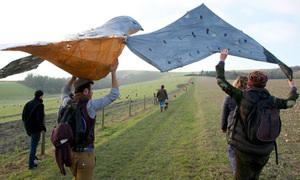GR: The book, “Lost Animals” by Errol Fuller brings out a tear or two. The sixth Remembrance Day for Lost Species is November 30th.
“In early 2010, artist, activist and mother, Persephone Pearl, headed to the Bristol Museum. Like many concerned about the fate of the planet, she was in despair over the failed climate talks in Copenhagen that winter. She sat on a bench and looked at a stuffed animal behind glass: a thylacine. Before then, she’d never heard of the marsupial carnivore that went extinct in 1936.
“Here was this beautiful mysterious lost creature locked in a glass case,” she said. “It struck me suddenly as unbearably undignified. And I had this sudden vision of smashing the glass, lifting the body out, carrying the thylacine out into the fields, stroking its body, speaking to it, washing it with my tears, and burying it by a river so that it could return to the earth.”
Pearl felt grief, deep grief, over the loss of a creature she’d never once seen in life, a species that had been shot to extinction because European settlers had deemed it vermin. Yet, how do we grieve for extinct species when there are no set rituals, no extinction funerals, no catharsis for the pain caused by a loss that in many ways is simply beyond human comprehension? We have been obliterating species for over ten thousand years – beginning with the megafauna of the Pleistocene like woolly rhinos, short-faced bears and giant sloths – yet we have no way of mourning them.

“Still, Pearl didn’t push the grief under or ignore it. Instead, she sought to share it. In 2011 Pearl, who is the co-director of the arts group, ONCA, and the theater group Feral in Brighton, helped organize the first ever Remembrance Day for Lost Species. Held every November 30th, it’s since become a day for activists, artists and mourners to find creative ways to share their grief for extinct species – and reinvigorate their love for the natural world.” –Jeremy Hance (continue reading: Why don’t we grieve for extinct species? | Environment | The Guardian)

